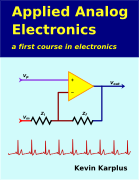The simplified class-D amplifier using a cMOS H-bridge works! Using an inverter chip (in this case a 74HC14N Schmitt trigger chip) to provide separate amplifiers for each nFET and pFET allows using the TLC3702 rail-to-rail comparator, despite its rather wimpy current output. Using an H-bridge allows 10V swing with only a single 5V power supply (in my case, just USB power from my laptop). Driving an inductive load (a 220µH inductor in series with an 8Ω loudspeaker) got clean 800ns rise and fall times, and the LC filter design made almost all the PWM carrier frequency disappear from across the loudspeaker. I got no noticeable shoot-through current, and I couldn’t see the Miller plateaus on the gate voltages (I’ll check that again tomorrow with my faster analog oscilloscope—I was just looking at the signals with the Bitscope B10 with the DP02 differential probe).
I was getting a rather annoying amount of 60Hz hum, probably from the microphone preamplifier. I’ll have to play with it a bit tomorrow to see if I can avoid the hum pickup.
The high frequency triangle waves from the FG085 function generator are not very good, but I cleaned up the digital-to-analog converter steps by adding a 10nF capacitor across the output. With the ~47Ω output resistance of the FG085, this makes a 340kHz low-pass filter, which is fine for triangle waves around 50—100kHz. Any larger capacitor and the waveforms started getting too sinusoidal.
I think I’ll rewrite the Class-D lab around an H-bridge design, rather than the open-collector comparators and 3 power supplies. The parts are about $1.50 more (extra nFET and pFET, more expensive comparator, extra inverter chip), but the design is much simpler, and the PWM waveform clearer.




[…] H-bridge Class-D works I […]
Pingback by H-bridge Class-D hum problem solved | Gas station without pumps — 2015 September 17 @ 17:13 |